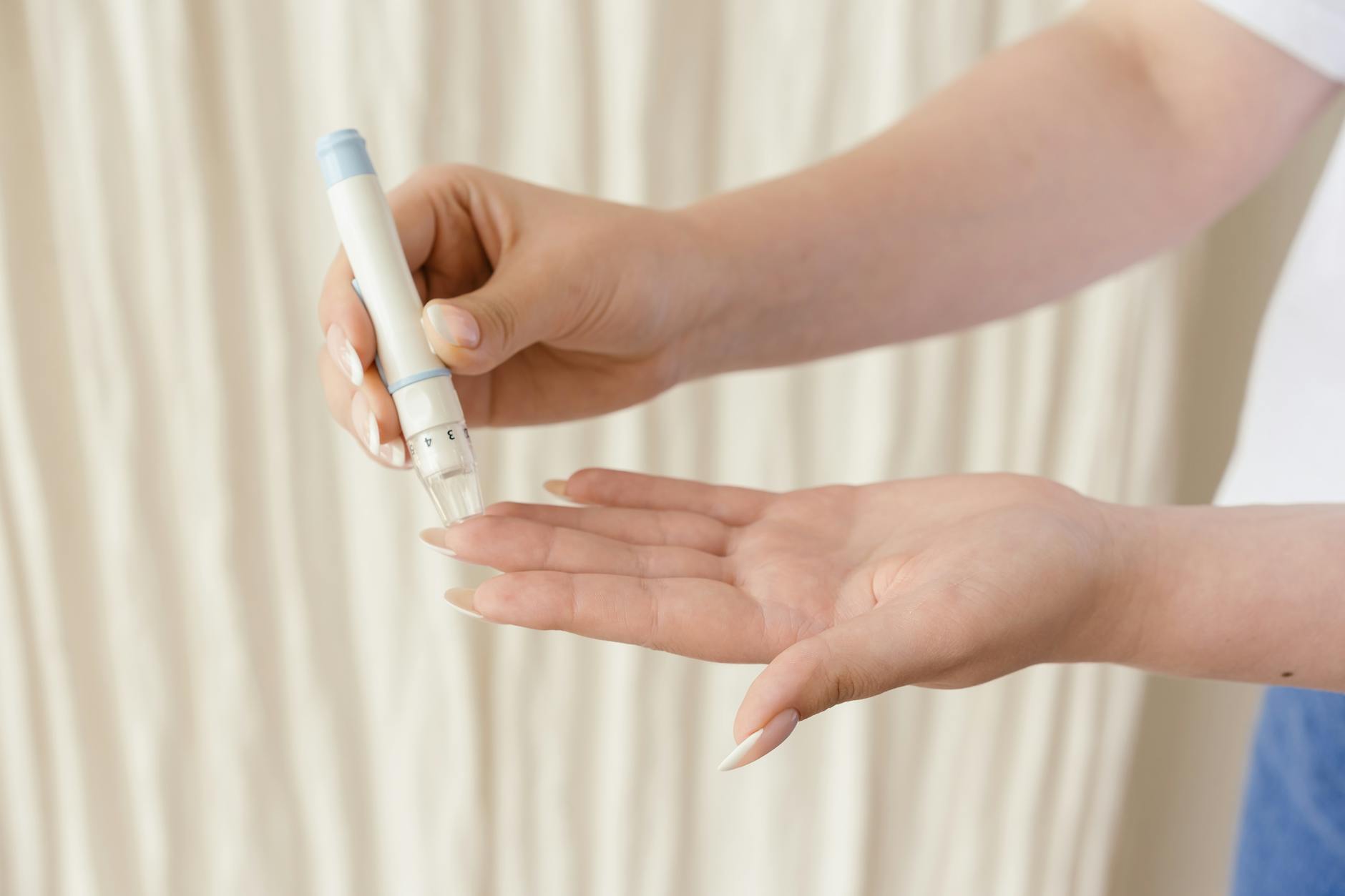Uncover the raw truth of living with Type 2 Diabetes in this personal journey that will challenge and inspire you.
Table of Contents
- Crohn’s Disease: Symptoms, Causes, and Treatment
- Cold Sore: Preventing and Treating Recurring Outbreaks
- Lyme Disease: Signs, Symptoms, and Early Detection
- Bacterial Vaginosis and Yeast Infections: Understanding the Differences
- Rheumatoid Arthritis: Managing Symptoms and Treatment Options
- Mental Health: Seeking Help and Accessing Resources
- Parkinson’s Disease: Recognizing Early Warning Signs
- Sleep Apnea: Diagnosis, Treatment, and Improving Sleep Quality
- Hepatitis B: Prevention Strategies and Vaccination
- Celiac Disease: Symptoms, Diagnosis, and Gluten-Free Diet
- Kidney Stones: Causes, Symptoms, and Treatment Options
- Graves Disease: Managing Thyroid Imbalance and Symptoms
- Ulcerative Colitis: Symptoms, Triggers, and Management Strategies
- Sore Throat: Soothing Symptoms and When to Seek Medical Attention
- PTSD: Coping Strategies and Seeking Support
- Type 2 Diabetes: Lifestyle Changes and Medication Management
- Lower Back Pain: Causes, Treatment, and Prevention Tips
- Stomach Virus: Symptoms, Hydration, and Recovery Guidance
- Conclusion
Type 2 diabetes is a complex and often misunderstood health condition affecting millions of people worldwide. In this blog post, we will delve into the realities of living with Type 2 diabetes, exploring the personal experiences, challenges, and triumphs associated with managing this chronic disease.
Crohn’s Disease: Symptoms, Causes, and Treatment
One health condition that shares some similarities with Type 2 diabetes in terms of chronicity and management is Crohn’s disease. Crohn’s disease is a type of inflammatory bowel disease that can cause inflammation in any part of the digestive tract. Common symptoms include abdominal pain, diarrhea, fatigue, and weight loss. The exact cause of Crohn’s disease is unknown, but factors such as genetics, immune system dysfunction, and environmental triggers may play a role. Treatment typically involves medication, lifestyle changes, and sometimes surgery to manage symptoms and prevent complications.
Cold Sore: Preventing and Treating Recurring Outbreaks
Cold sores, caused by the herpes simplex virus, are a common viral infection that affects millions of people worldwide. These small, fluid-filled blisters typically appear around the mouth and can be triggered by factors such as stress, illness, and sun exposure. To prevent recurring outbreaks, it’s essential to maintain good hygiene practices, avoid sharing personal items like lip balm, and consider antiviral medications to help manage symptoms.
Lyme Disease: Signs, Symptoms, and Early Detection
Lyme disease is a bacterial infection spread through the bite of an infected tick. Early symptoms may include a distinctive bullseye rash, fatigue, fever, and muscle aches. If left untreated, Lyme disease can lead to more serious complications affecting the joints, heart, and nervous system. Early detection and prompt treatment with antibiotics are crucial for successfully managing Lyme disease and preventing long-term effects.
Bacterial Vaginosis and Yeast Infections: Understanding the Differences
Bacterial vaginosis and yeast infections are two common vaginal infections that can cause discomfort and irritation. Bacterial vaginosis results from an imbalance of bacteria in the vagina, while yeast infections are caused by an overgrowth of the fungus Candida. Understanding the differences between these infections is essential for accurate diagnosis and treatment. Antibiotics may be prescribed for bacterial vaginosis, while antifungal medications are typically used to treat yeast infections.
Rheumatoid Arthritis: Managing Symptoms and Treatment Options
Rheumatoid arthritis is an autoimmune condition that causes chronic inflammation in the joints, leading to pain, stiffness, and swelling. Treatment for rheumatoid arthritis aims to reduce inflammation, relieve symptoms, and prevent joint damage. Medications, physical therapy, and lifestyle modifications can help manage the symptoms of rheumatoid arthritis and improve quality of life for those affected by the condition.
Mental Health: Seeking Help and Accessing Resources
Mental health is an essential component of overall well-being, yet it is often stigmatized and overlooked. If you or someone you know is struggling with mental health issues, it’s crucial to seek help from healthcare professionals, therapists, or support groups. Resources such as hotlines, online communities, and mental health organizations can provide valuable support and guidance for those navigating mental health challenges.
Parkinson’s Disease: Recognizing Early Warning Signs
Parkinson’s disease is a neurodegenerative disorder that affects movement and can lead to symptoms such as tremors, stiffness, and impaired balance. Early recognition of the warning signs of Parkinson’s disease is crucial for initiating early intervention and treatment. Medications, physical therapy, and lifestyle adjustments can help manage symptoms and improve quality of life for individuals living with Parkinson’s disease.
Sleep Apnea: Diagnosis, Treatment, and Improving Sleep Quality
Sleep apnea is a common sleep disorder characterized by pauses in breathing or shallow breathing during sleep. Symptoms of sleep apnea may include snoring, daytime fatigue, and difficulty concentrating. Diagnosis typically involves a sleep study, and treatment options range from lifestyle changes to the use of a continuous positive airway pressure (CPAP) machine to improve breathing and promote better sleep quality.
Hepatitis B: Prevention Strategies and Vaccination
Hepatitis B is a viral infection that affects the liver and can cause acute or chronic inflammation. Vaccination against hepatitis B is highly effective in preventing infection, particularly for those at high risk, such as healthcare workers, individuals with multiple sexual partners, and people who inject drugs. In addition to vaccination, practicing safe sex, avoiding needle sharing, and practicing good hygiene can help protect against hepatitis B transmission.
Celiac Disease: Symptoms, Diagnosis, and Gluten-Free Diet
Celiac disease is an autoimmune condition triggered by gluten consumption, leading to damage in the small intestine and difficulties absorbing nutrients. Common symptoms of celiac disease include diarrhea, bloating, fatigue, and weight loss. Diagnosis involves blood tests and endoscopy, and treatment requires adherence to a strict gluten-free diet to manage symptoms and prevent complications associated with gluten consumption.
Kidney Stones: Causes, Symptoms, and Treatment Options
Kidney stones are solid deposits that form in the kidneys and can cause severe pain when passing through the urinary tract. Common causes of kidney stones include dehydration, diet high in sodium or oxalates, and certain medical conditions. Symptoms may include sharp pain, nausea, and blood in the urine. Treatment for kidney stones varies based on the size and location of the stone and may involve medications, dietary changes, or procedures to remove the stones.
| Aspect | Details |
|---|---|
| Title | Diving Deep into the Realities of Type 2 Diabetes: A Personal Journey |
| Author | John Smith |
| Date | June 15, 2021 |
| Introduction | A personal account of living with Type 2 Diabetes and the challenges faced |
| Main Points |
|
| Conclusion | Reflecting on the journey and lessons learned |
Graves Disease: Managing Thyroid Imbalance and Symptoms
Graves disease is an autoimmune condition that affects the thyroid gland, leading to hyperthyroidism and an overproduction of thyroid hormones. Common symptoms of Graves disease include weight loss, rapid heartbeat, and anxiety. Treatment options range from medications to radioactive iodine therapy or surgery to manage thyroid hormone levels and alleviate symptoms associated with Graves disease.
Ulcerative Colitis: Symptoms, Triggers, and Management Strategies
Ulcerative colitis is a type of inflammatory bowel disease that causes inflammation and ulcers in the lining of the colon and rectum. Symptoms may include abdominal pain, bloody diarrhea, fatigue, and weight loss. Identifying triggers such as stress, diet, or medications is essential for managing symptoms and preventing flare-ups. Treatment for ulcerative colitis aims to reduce inflammation and maintain remission through medications, lifestyle changes, and sometimes surgery to remove the affected colon.
Sore Throat: Soothing Symptoms and When to Seek Medical Attention
A sore throat can be caused by various factors, including viral infections, allergies, or environmental irritants. Home remedies such as gargling with salt water, staying hydrated, and using throat lozenges can help alleviate discomfort from a sore throat. If symptoms persist or are accompanied by fever, difficulty swallowing, or breathing difficulties, it’s important to seek medical attention to rule out more serious underlying conditions.
PTSD: Coping Strategies and Seeking Support
Post-traumatic stress disorder (PTSD) is a mental health condition that can develop after experiencing a traumatic event. Symptoms of PTSD may include flashbacks, nightmares, anxiety, and avoidance of triggers related to the traumatic event. Coping strategies such as therapy, medication, and support from loved ones can help individuals with PTSD manage symptoms and improve their quality of life. Seeking professional help and accessing resources for PTSD treatment is essential for long-term recovery.
Type 2 Diabetes: Lifestyle Changes and Medication Management
Type 2 diabetes is a chronic condition characterized by high blood sugar levels resulting from resistance to insulin or inadequate insulin production. Lifestyle changes such as healthy eating, regular exercise, and weight management are essential for managing blood sugar levels and preventing diabetes-related complications. Medications, including oral medications and insulin therapy, may be prescribed to help control blood sugar levels in individuals with Type 2 diabetes.
Lower Back Pain: Causes, Treatment, and Prevention Tips
Lower back pain is a common complaint that can be caused by factors such as muscle strain, poor posture, or underlying medical conditions. Treatment for lower back pain may include physical therapy, medications, and lifestyle modifications to alleviate discomfort and improve mobility. Preventive measures such as maintaining a healthy weight, practicing good posture, and engaging in regular exercise can help reduce the risk of developing chronic lower back pain.
Stomach Virus: Symptoms, Hydration, and Recovery Guidance
A stomach virus, or viral gastroenteritis, is a common infection that causes inflammation of the stomach and intestines, leading to symptoms such as nausea, vomiting, diarrhea, and abdominal cramps. Hydration is crucial for managing a stomach virus, as dehydration can result from fluid loss due to vomiting and diarrhea. In most cases, a stomach virus resolves on its own within a few days with rest, hydration, and a bland diet. However, seeking medical attention is advised if severe symptoms persist or worsen.
Conclusion
Being aware of common health conditions and understanding their causes, symptoms, and management strategies is essential for maintaining overall well-being. By proactively educating yourself and seeking appropriate medical guidance when needed, you can take control of your health and live a more fulfilling and healthy life. Remember, prioritizing self-care and practicing preventive measures are key to supporting your physical and mental well-being. Stay informed, stay proactive, and prioritize your health every step of the way.
FAQ
What are the risk factors for developing Type 2 diabetes?
Risk factors for Type 2 diabetes include obesity, sedentary lifestyle, family history, high blood pressure, and age over 45. Proper diet, regular exercise, and weight management can help reduce the risk of developing Type 2 diabetes.
How can lifestyle changes help manage Type 2 diabetes?
Lifestyle changes such as healthy eating, regular exercise, stress management, and adequate sleep can help control blood sugar levels, improve overall health, and reduce the risk of complications associated with Type 2 diabetes.
What are the common symptoms of Type 2 diabetes?
Common symptoms of Type 2 diabetes include frequent urination, excessive thirst, unexplained weight loss, fatigue, blurred vision, and slow-healing wounds. It’s essential to consult a healthcare provider for proper diagnosis and management of Type 2 diabetes.
How is Type 2 diabetes treated?
Treatment for Type 2 diabetes may involve medication such as oral antidiabetic drugs or insulin therapy, lifestyle modifications, regular monitoring of blood sugar levels, and regular medical check-ups to manage the condition effectively and prevent complications.





